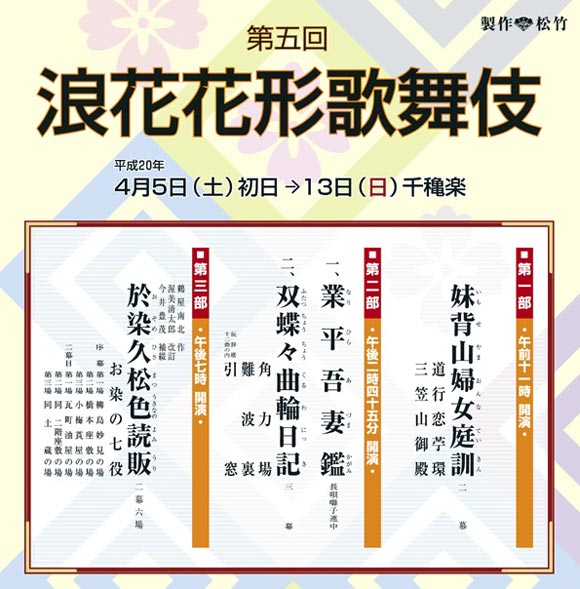| APRIL 2008 |
|
2 shows in T˘ky˘ (Kabukiza), 1 in Nagoya (Misonoza), 3 in ďsaka (Sh˘chikuza), 1 in Fukuoka (Hakataza), 1 in Ky˘to (Minamiza), 2 on Shikoku island (Kanamaruza) and 1 in Kumamoto (Kumamoto Castle)!
|
| Kabukiza (T˘ky˘) |  |
| Dates | 2 ~ 26 April 2008 (Shigatsu ďkabuki) |
| MatinÚe | |
| Evening |
Ukare Shinjű |
| Casting |
Band˘ Tamasabur˘, Kataoka Nizaemon, Nakamura Kanzabur˘, Band˘ Mitsugor˘, Nakamura Tokiz˘, Kataoka Gat˘, Nakamura Hashinosuke, Kataoka Hidetar˘, Band˘ Yajűr˘, Nakamura Shichinosuke |
| Comments |
|
| Misonoza (Nagoya) |  |
| Dates | 1 ~ 24 April 2008 (Y˘shun ďkabuki) |
| MatinÚe |
Hirakana Seisuiki (Genta Kand˘) Onihei Hankach˘ (ďkawa no Inkyo) |
| Evening |
Enma to Seirai Yowa Nasake Ukina no Yokogushi (Kirare Yosa)
|
| Casting |
Nakamura Kichiemon, Ichikawa Sadanji, Nakamura Shibajaku, Nakamura T˘z˘, Nakamura Karoku, Nakamura Kash˘, Ichikawa Somegor˘ |
| Comments |
|
| Kanamaruza (Konpira) |
| Dates | 5 ~ 23 April 2008 (Shikoku Konpira Kabuki ďshibai) |
| MatinÚe | |
| Evening |
|
| Casting |
Ichikawa Ebiz˘, Ichikawa Unosuke, Kataoka Ichiz˘, Ichikawa Omez˘, Band˘ Kametoshi, Onoe Matsuya, Onoe Ukon |
| Comments |
24th edition of the Spring Kabuki performance Shikoku Konpira Kabuki ďshibai at the Kanamaruza on Shikoku Island.
|
| Sh˘chikuza (ďsaka) |
| Dates | 5 ~ 13 April 2008 (Naniwa Hanagata Kabuki) |
| MatinÚe |
|
| Afternoon |
Narihira Azuma Kagami
|
| Evening | |
| Casting |
Nakamura Kanjaku, Nakamura Senjaku, Kataoka Ainosuke, Nakamura Kikaku, Kataoka Takatar˘, Band˘ Takesabur˘, Band˘ Shinsha, Kataoka Shinnosuke, Nakamura Kazutar˘ |
| Comments |
5th edition of the Naniwa Hanagata Kabuki April program, staged by a troupe of young Kamigata actors.
|
 |
|
|
|||
| Dates | 20 ~ 26 April 2008 (Kabuki Kansh˘ Ky˘shitsu) | ||
| Program | |||
| Casting | |||
| Comments |
16th edition of a pedagogical show in Ky˘to combining explanation for beginners (done by the professional storyteller Katsura Kujaku) and the dance-drama "Hanabusa Shűjaku no Shishi": lion dances (shishi) show a vigorous masculine spirit that is the guardian of a sacred mountain in China. But the Kabuki tradition transforms this fierce dance into a showpiece for an elegant female role specialist. Kamimura Kichiya stars as a top-ranking courtesan elegantly in a banquet parlor who is then transformed into a feminine version of the spirit of the lion. |
||
|
|||
| Dates | 3 ~ 26 April 2008 (Super Kabuki) | ||
| Program | Yamato Takeru | ||
| Casting |
Ichikawa Ukon, Ichikawa Danjir˘, Ichikawa Emiya, Ichikawa Monnosuke, Ichikawa Emisabur˘, Ichikawa Shun'en, Ichikawa En'ya, Ichikawa Juen, Kaneda Ryűnosuke |
||
| Comments |
Ichikawa Ennosuke's troupe of young and talented actors perform a modern style of theater, which they created a few years ago and called "Super Kabuki" (SűpÔ Kabuki in Chikamatsu Monzaemon's lingo): it's spectacular (lots of chűnori), the costums are gorgeous and ultra-sophisticated, the music is modern, the texts are easy to understand and the plots are as twisted as a good Kabuki classic. Usually a big commercial success! "Yamato Takeru" was the first SűpÔ Kabuki drama of the Omodakaya guild and the most successful one. For this revival, the leading role of Yamato Takeru is played by both Ichikawa Danjir˘ and Ichikawa Ukon. Ichikawa Ennosuke is on sick leave and does not perform in this production. |
||
| Kumamoto Castle (Kumamoto City) | |
| Dates | 30 April 2008 (Band˘ Tamasabur˘ Tokubetsu Buy˘ K˘en) |
| Program | |
| Casting | |
| Comments |
A special Buy˘ program to end the celebrations of the 400th anniversary of the Building of the Kumamoto Castle (built in 1607), which started the 31st of December 2006 and will end in Spring 2008. There is no entrance fee for this dance program. |
|
|
| Contact | Main | Top | Updates | Actors | Plays | Playwrights | Programs | Links | FAQ | Glossary | Chronology | Illustrations | Prints | Characters | Derivatives | Theaters | Coming soon | News |
